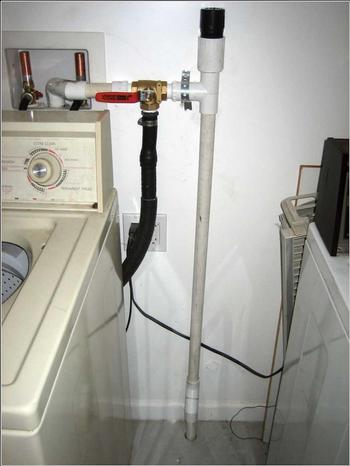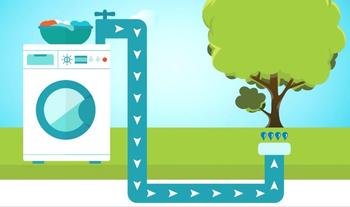Starting a graywater system
-
Jane Scurich
-
Water is a precious resource; conserving it is a key to earth-friendly gardening.
 Simple DIY connections can be made to your washer to direct graywater to your landscape. Photo: UC Master Gardeners, SLO County, CA
Simple DIY connections can be made to your washer to direct graywater to your landscape. Photo: UC Master Gardeners, SLO County, CAWe have been blessed with abundant rainfall, magnificent waterfalls, and fast-moving creeks this past winter. But where is all that flowing water heading? Unfortunately, not into more reservoirs or water storage facilities. The reality is that we still need to think about water and using our resources wisely.
Graywater has been discussed widely during our long drought years. Is this the year to plan for greywater use in your garden? If the thought of a future drought is not a motivator, how about the increasing cost of Marin Municipal water?
Some people seem to be a bit squeamish about the concept of watering the garden with “dirty” water. A clear definition of what is considered graywater is found in “Shades of Graywater,” an informative brochure (https://ucanr.edu/sites/MarinMG/files/192094.pdf) compiled by Marin Master Gardeners.
- Gray water is untreated wastewater collected from bathtubs, showers, washing machines, and bathroom sinks, and reused for outdoor irrigation or toilet flushing.
- Dark graywater is water from kitchen sinks and dishwashers that may have a high content of organic matter, encouraging bacterial growth.
- Black water is toilet wastewater or water that has touched soiled diapers. Neither dark graywater nor black water is allowed to be re-used in landscape irrigation.
Installing your simple home graywater “laundry-to-landscape” (L2L) system requires no permits. This system uses discharge water only from a single domestic clothes washing machine in a 1- or 2- family dwelling that distributes it to the yard for subsurface irrigation of landscape plants. These DIY systems are generally the easiest and least expensive ways to make graywater usable in your landscape.Some basic usage guidelines: Laundry washer water can be recycled for landscape irrigation using a laundry to landscape system. Photo: Pasadena Water and Power
Laundry washer water can be recycled for landscape irrigation using a laundry to landscape system. Photo: Pasadena Water and Power- Graywater is to be used on ornamental shrubs, fruit trees, and edibles that do not reach the ground.
- Use only biodegradable, pH-balanced, and sodium, boron, and chlorine-free laundry products.
- Rinse cycle water is preferable to wash cycle discharge.
- Do not irrigate leafy greens or root vegetables with graywater.
- Watering a lawn is not the best use of graywater.
- The irrigation area should be downhill from the clothes washing machine.
- Graywater must be discharged into the soil under two inches of cover material.
- Graywater is not to be used in spray irrigation or allowed to pool or run off the owner's property.
- Do not discharge graywater near a freshwater source.
- Alternate graywater irrigation with fresh water to minimize salt buildup.
- Avoid human and pet contact with graywater to minimize potential health risks.
More complex graywater systems that discharge more than 250 gallons per day and may also involve pumps, tanks, and filtration systems may require one or more permits.
Information for the do-it-yourselfer as well as resources for professional designers and installers, can all be found at https://marinmg.ucanr.edu/BASICS/CONSERVE_WATER_-_ENERGY/Graywater/. This page also includes links to an L2L pamphlet and extensive information from the County of Marin. Included on the County website are FAQs and lists of specific plants that do and do not benefit from graywater irrigation.
With as much as 30% – 50% of residential water usage producing graywater, any reuse is a helpful savings of our precious drinking water. If laundry-to-landscape is just not for you, put a bucket in your shower to collect water as it warms to your liking and use this water to flush your toilet – simple, easy, anyone can do it graywater usage!
Graywater use is not only a water-saving practice. Transporting clean potable water from the source to your home is an expensive use of energy. Reusing water that is already in your dwelling can result in both water and energy savings: a double win for both you and Mother Earth!


